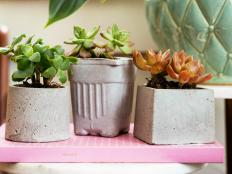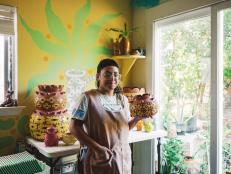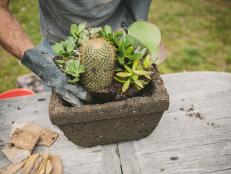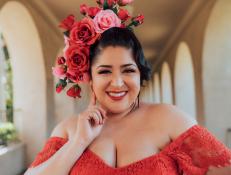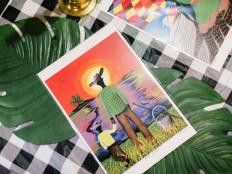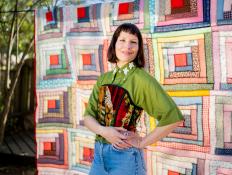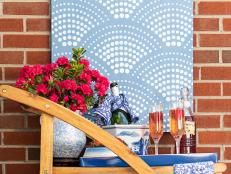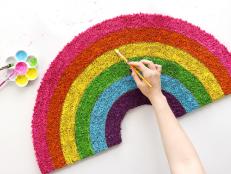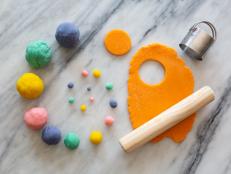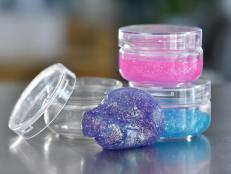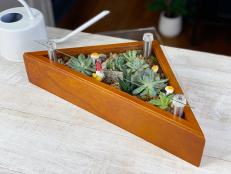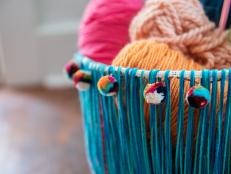How Bethany Yellowtail Is Creating a Legacy of Intentional Design for More Indigenous Makers to Thrive
The CEO of fashion label B.Yellowtail focuses on reclaiming Indigenous motifs appropriated in big brand apparel and textiles. Meet the maker and learn how she’s following her creative path off the runway at home.

B.Yellowtail

Bethany Yellowtail isn’t really interested in talking about the celebrities she’s styled or the biggest collections she’s designed or all the awards she’s won. That was her career in LA in corporate fashion. Now, she’s back home in Crow Country, at the helm of her own label B.Yellowtail and doing what she was always meant to do: Intentional Indigenous design full of authentic patterns with significance and stories.
“I always knew that I wanted to have my own brand,” she says. “Working in the industry, I saw the way that we are not represented and the way that fashion makes a lot of money off of Indigenous culture. I come from a really vibrant community and our cultural ways are very strong here. It didn’t represent me or the people that I come from and that I love, and I wanted to create fashion that does.”
11 American Indian and Alaskan Native-Founded Home Brands We Love to Shop
Support these Indigenous-owned businesses throughout your home and life.
Yellowtail launched in December 2014 on Bethany’s birthday. “That was very Sagittarius of me,” she laughs. It was her first collection with her own manufactured pieces and it featured a design that belonged to her great-great-grandmother Irene Not-Afraid Yellowtail. “She had some really beautiful beadwork that has been passed down to my sister and I — a beautiful beaded handbag and some moccasins. So, I utilized that design and translated it into a textile design.”

B.Yellowtail
Rich, bold colors dominate Bethany’s work. And these palettes don’t come from runway trends. They come from her Apsáalooke and Cheyenne heritage.
“For Crow design or Apsáalooke design, we have a color family,” she says. “For Crow colorways, we don’t use black. And those are just cultural rules. So, I try to listen and follow those. Whereas on the flip side, I’m enrolled in Northern Cheyenne and our primary colors are black, red, yellow, white, blue and green. A year and a half ago, I released a whole collection that was a nod to that — the medicine wheel colors. There’s a lot of black and red and yellow and white. And right now, we’re in this very colorful, vibrant seasonal collection, and we’re about to release our Spring/Summer collection in the same tones with feminine, bright colorways.”
In a decade, B.Yellowtail has become its own fashion house. It’s shoppable on the B.Yellowtail website, and has been featured in the Smithsonian National Museum of the American Indian and other museum stores in the US. Business is growing and it’s home now. Bethany’s expanded from just apparel and accessories to focus on home goods, too. It’s a design shift inspired by her life. Last year, Bethany moved everything remote so that she could be at home in Montana with her family and close to her people. The home goods she’s designing are a direct reflection of the things she uses in her daily life.
“I was like, ‘I want to make my own apron so that when we’re at camp cooking we can all have a nice apron,’” she says. “Food is so central and integral to our cultural doings, so I wanted to make aprons for our homes. And as an Indigenous woman, I know that will be useful to me, and I know it will be useful to other Native women. And non-Native women. You know the journals and the candles: These are things I want in my own home.”
Another major business shift: releasing her own fabrics. It’s not something most fashion designers are willing to do and yet, for Bethany, sharing her patterns with other makers is something she’s most proud of.
“I chose to start selling our designs so that other people can make their own things,” she says. “And many of them make businesses out of that. And that’s a beautiful thing to me. Knowing that us releasing our textiles — our icon motifs — could create businesses within itself for people. That’s always been important to me to find ways to elevate our communities and elevate our people.”
And, yes, it’s OK to buy these if you’re not Indigenous.
“One of the biggest questions we’ve been asked from non-Indigenous folks is if it’s OK to use it,” says Bethany. “My answer is yes. There’s so many crafters and quilters and DIYers out there. I invite them no matter where they come from. If they’re drawn to a design or a textile, it’s absolutely OK and we welcome it. I only design and make and sell things that I know people from all walks of life can wear. Even our Rez Girls tee. If someone wants to wear it and rock it and be an ally, that’s awesome. We don’t make and sell things that are deemed sacred for non-Native people to wear.”
Elk ivory is B.Yellowtail’s most-recognized motif. It’s been a part of Bethany’s designs since the first collection, and she says she brings it back often because it’s an incredibly important symbol.
“If someone gives you elk teeth, it’s like getting diamonds,” she says. “Here in Crow Country, we call them Apsáalooke Diamonds because our traditional dresses are fully adorned with elk teeth. And those specific incisor teeth on the elk — there’s only two — so you can imagine how many elk it takes to fully finish a dress. Some of our families have old dresses from our great grandparents that have full elk teeth all the way down, but it’s really rare because that’s not our way of life anymore where we have to hunt that many elk anymore.”
These printed fabrics convey that same love in a modern way. Same for her ribbon patterns. So far, B.Yellowtail has released two spools to buy. One is a nod to old Apsáalooke regalia. The larger ribbon is a nod to the Bighorn Mountains and four directions in a Cheyenne design style.
“Both of them represent our homelands and the mountains that we come from,” she says. “A lot of the geometric designs that come from our culture are reflections of the world around us. And for our world, the mountains are really important to us. They’re sacred to us. Specifically the Bighorn Mountains or the Rocky Mountain Range. They’re our origin story, so we give a lot of thanks and gratitude to the mountains. The four directions are integral to our prayer life and spirituality.”
Spiritual intention is a hallmark of Bethany’s work. She doesn’t follow Big Fashion schedules or the cadence of runway cycles anymore. “For years, I felt like I was always behind and I’m always late,” she says. “Now, I give myself more grace and space to design. I don’t like to make things that I don’t really love. Everything that I make has thought. In my creative practice, I pray and I give gratitude and I think about where this design will go and the people that it may touch. And that it’s always done in a good way.
“I decided that I’m just going to do it our way and create products that I love and designs that are inspired,” she says. “And sometimes that creativity ebbs and flows ... For a creative person, it’s really challenging, but also as an Indigenous person, it’s really challenging because our teachings tell us that we’re not supposed to create things when we’re in a bad way or mourning. So the things that we design and create, I really take a lot of care in that I’m in a good mind state or good way because they touch so many people. And I want people to feel good and feel that prayer and intention.”
She also wants people to feel empowered by her designs. “My favorite thing about seeing people out in the world wearing my work is that they wear it to some of the most monumental points in their life or important doings in their life,” she says. “Like landmarks in their life. That it makes them feel strong and protected and empowered.”
That’s why Bethany made the “Rez Girls Can Do Anything” T-shirt. She created the campaign to celebrate and empower young women in her community and to change the narrative about being from a reservation.
“I’m a Rez Girl,” she says. “I was raised on a reservation, and I have a huge, giant family. There’s tons of girls in my family. And the two reservations I come from and the county that encompasses the majority of our reservation has one of the highest rates per capita in the US for missing and murdered Indigenous women. And those are Rez Girls.”
Partial proceeds from the T-shirts go to the Native Wellness Institute, an Indigenous-founded non-profit providing culturally responsive wellness and healing-related training and technical assistance to Indigenous communities. And in partnership with the Native Wellness Institute, B.Yellowtail’s Rez Girls Mentorship Fund includes workshops, retreats and mentorship opportunities for young girls, women and two-spirit relatives.
“It’s so important for our young people to see themselves as valuable and see themselves in mainstream culture,” she says, “and not be a trope or a mascot. Those things have had a real effect on how we think of ourselves, and how much value we put on ourselves. And so I wanted to create this campaign that celebrated us.
“That slogan has taken off,” she says. “And I love seeing res girls — not just in my community — wearing it and believing in themselves. Because when you come from places like where we come from, it takes extra strength. It takes an extra belief in yourself to overcome obstacles. It takes courage to achieve these things.”
23 American Indian and Alaskan Native Books to Fill Your Home
Support Indigenous authors and creators with books for every room, from kids' crafts to cookbooks to the perfect new coffee table book.
Bethany is proof of that courage. Rez Girls don’t have as many opportunities, especially when they want to break into the fashion industry. The area she’s from has over a 75% unemployment rate and many live well below the poverty line.
“We don’t have a lot of resources where we’re from and that’s unacceptable to me to see our cultural inheritance being taken from us when so many of our people are still just trying to survive,” she says. “It was important for me to create a business that not only tells my own story but tells stories from my own culture and that also benefits our community in different capacities, whether it's advocating for issues or working with nonprofits that help our people. To me, even though I’m a small brand, I always have a component of giving back because that’s a value that’s instilled in me, and I love our people.”
It’s full circle. The Rez Girl who wanted to leave home is back home. And while her fashion label isn’t big, her impact and legacy are.
“I’m in a new transition and chapter of B.Yellowtail and I’m really looking forward to it unfolding in the way that it’s meant to,” she says. “I know that with these fabrics and textiles and this direction we’ve gone in will enable people to make and create their own special things — and things to express themselves and their own creativity. I know that the prayers I prayed to be here and those fabrics have enabled me to come home and participate in being with my community again.”
.-Battle-on-the-Beach-courtesy-of-HGTV.-.jpg.rend.hgtvcom.196.196.suffix/1714847929029.jpeg)






































